All the tours happened in Mishawaka, Indiana,
and northwest of Grand Rapids, Michigan.
First “Next-Generation” Tour
(June 1992)
People — Lyman Wood (1914-1996), Agnes Hawkins Elliott (1917-1999), Fred and Esther Gross, Joy Divine Butiste and John Sholty, Don and Ginger Gross, Laurie Gross, Lynée Gross
The first “tour” where I had the pleasure of taking others to visit those family history sites happened in 1992 when my children and a few other family members indulged me by letting me take
them along. A special and never to be repeated thing about that tour was that our Aunt Agnes and
cousin-in-her-generation Lyman Wood went along with us, as did cousin-in-my-generation Joy and the man who would become her husband later that year. Well before another tour would take place, both Agnes and Lyman would be gone on to join the ancestors.
Of course we started the tour in Mishawaka at the St. Joseph Memorial Gardens cemetery where our Hawkins grandparents are buried along with my brother Don Moneysmith, who died in 1964 at age 24. With the group gathered around, Dottie talked about our Hawkins grandparents and Don. Then we moved on to Michigan.
Our first stop in Chester Township northwest of Grand Rapids was to be the brick house, long the Porter house. On our way there, Lyman declared he “had a notion” to go up the door, knock, and ask if he could come in. He and his family had lived there a few years. Among other things, he wanted to see again the spot in the dining room where, when he was a child, his grandmother had led him to accept Jesus as his Savior.
As we turned into the gravel driveway of the house, we saw people on the back porch. The owner and his sons were making some repairs. Lyman introduced himself and explained that all of us were descendants of the long-time former owners. Not only was the owner eager to show us the site where Samuel had died, but he invited us into the house. Decades earlier the well had been filled in and capped off, but the story was still well remembered and recounted, even among non-family members.
Our host brought out a deep stack of black and white photos made from
glass negatives they had found in the attic. He said that Forrest Averill, a Stauffer descendant (who we learned years later had lived in the house as a child) had stopped by once and given names to as many of the people in the pictures as he could.
What a thrill it was to be on the property and to go inside the house, to stand in Great-grandma Porter’s kitchen (more about that kitchen under the 2008 Tour account), not to mention posing at the site where ancestor Samuel had died in the well/cistern (see “Trauma” under
Samuel and Letter to Samuel in Stauffer link). As for Lyman, he found the well-remembered corner in the dining room. Since he lived in the Grand Rapids area, he continued until his death to go to the cemeteries every Memorial Day and plant flowers by the graves.
After we finished at the house, we continued up the road to the little brick church on the corner that was my grandfather’s first pastorate. He had boarded with the farmer in the brick house down the road, and he fell in love with the daughter—and she with him. Someone was at the church that day, so we were invited in, which was also very special. It was a treasured experience to be in the sanctuary where Grandpa preached his earliest sermons. Undoubtedly he and Grandma were married there as well.
Another never-to-be-repeated element of that first tour was the part played by two great-nieces of our family’s Grandpa Ferd Porter. Mary Ellis Schoenborn [Shen’ bern] and her sister Jean were granddaughters of Mary Porter Lang, the daughter of George and Delilah Porter. I wish I remembered how and when (sometime in the 1980s) I got in touch with Mary Ellis in the first place, but for years after we discovered each other we had wonderful times sharing matters of Porter family history. When Mary Ellis and Jean heard about the family “ancestor tour” I was going to do, they insisted on having all of us at the Schoenborn farm for lunch that day. There were at least ten of us. They prepared a lovely picnic-style lunch (I remember the potato salad), and we had a great time. Both sisters have been gone now for many years.
Another fun part of this tour we had no idea would never be repeated. East of the church a mile so was the old school house where many of our ancestors, including our Grandma Fern Porter Hawkins, had attended. It was fun for us to peruse the grounds. I tell about it in Porter Schoolhouse under Porter.
In 1992 when we made our first family-history—or “ancestor”—tour, one of our stops was at the school. It was weathered, the bell was gone, and lush vines were enjoying a happy life on the outer walls, even across half the front door. We peeked in the windows but couldn’t see much. In our group that day were three school teachers of today’s generations—my daughter-in-law Ginger (Gentry) Gross, daughter Lynée Gross (now Ward), and me, so we posed for a picture sitting on what was left of the front stoop.
As we drove away down Truman Road, we didn’t know it was the last time we would see the school standing.
Highlights — Getting invited into the brick house; posing by the cistern; getting to go into the church; having lunch at Mary Ellis’s with Jean
Pictures
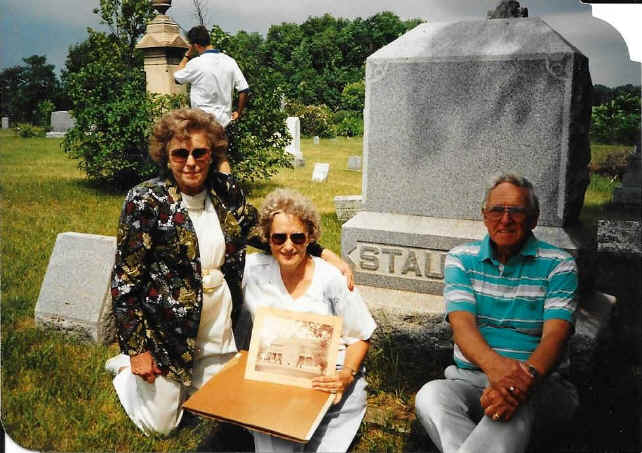
Agnes Elliott, Esther Gross, Lyman Wood
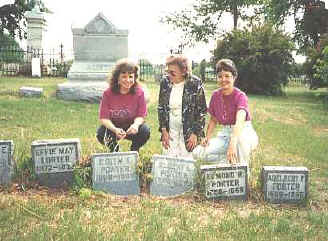
Laurie Gross (now Newman), Agnes Divine Elliott, Lynee Gross (now Ward)
behind the graves of the 5 Porter babies who died in infancy
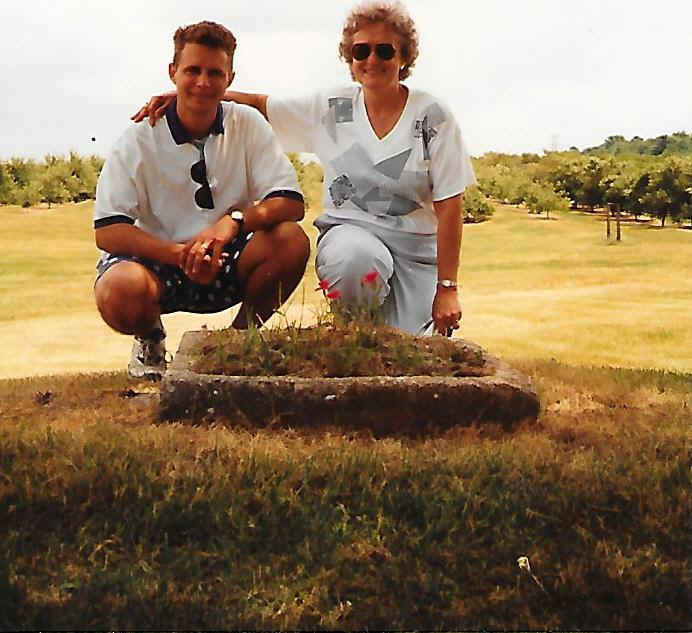
Scrapbook author Esther Gross and son Don Paul Gross by the capped head
of the cistern where Samuel Stauffer died
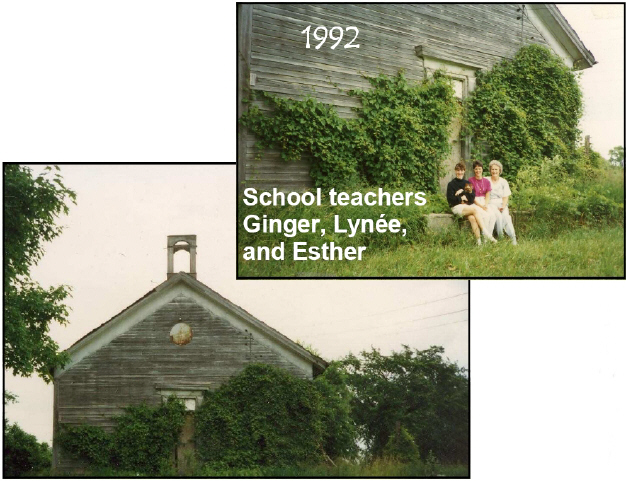
Porter schoolhouse as we saw it that day
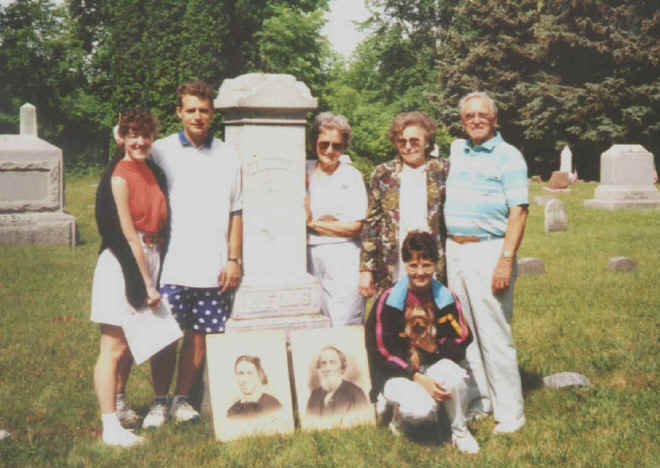
Ginger. Don Paul, Esther and Lynée Gross, Agnes Elliott and Lyman Woods
with Wells pictures by their headstone
Second Tour
(June 1992)
People — Esther Gross, Dottie Hoppe, Rachel and Tavi Rendón
My sister Dottie couldn’t make the trip with us on the day we did the tour with my children and other family members because she was busy with preparations for her son’s wedding, but she really wanted to do the tour. So the following weekend I took her, her daughter and son-in-law on the same tour.
A super important event I remember from a much earlier trip (and I wish I remembered more about it) was the time my mother and I discovered what would come to be known to us as “the white house.” I don’t remember the occasion that had both my mother and me in Grand Rapids and specifically in North Chester, nor do I remember who told us about that house, though it may well have been Mary Ellis Schoenborn and quite likely in the 1960s. That house had gone out of the family in 1908 when Grandma Fern was only fourteen, and it was not part of the “pilgrimages,” or tours, of my childhood.
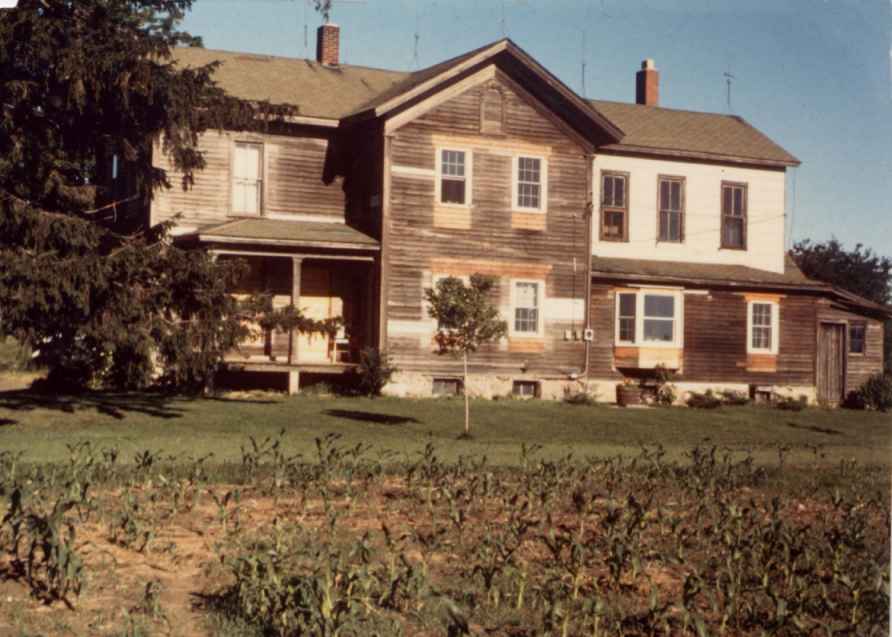
At the time Mother and I found it and took a couple of pictures, the house was far from white; in fact, it had been stripped of whatever 100-year-old paint was left in preparation for …well, read about its history in
George’s House under Porter in this
Scrapbook.
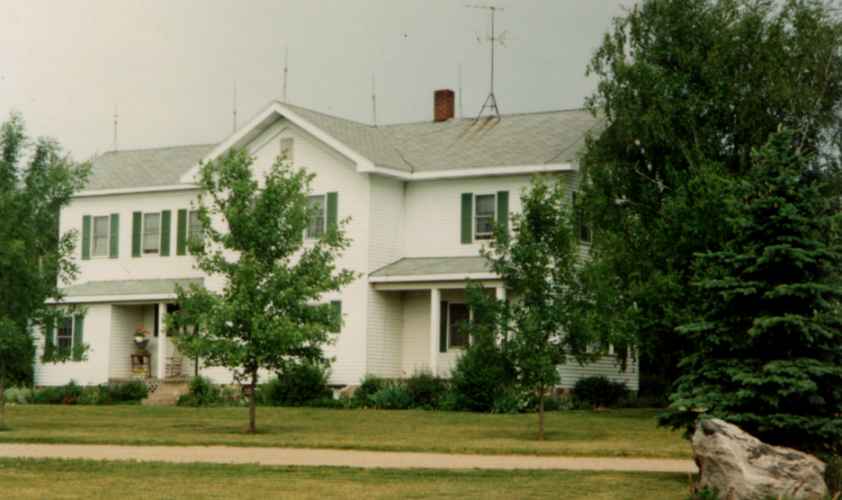
On that 1992 trip when Dottie and I drove past the by-then-white Porter house, we noticed people at a picnic table outside off the back corner the house, so we made a quick decision to turn in the driveway. They got up and came towards us.
“Can we help you?” they asked.
We responded, “Our great-great-grandfather built this house,” and that was the beginning of an amazing friendship and more than one memorable experience.
The owners immediately invited us in and let us look around, take pictures, and even go upstairs. What an awesome experience that was! I had no idea that day that I would have the pleasure of going inside that home at least three more times in the years ahead.
Highlight — Connecting with the Van Oeffelins and getting to go in the white house
Pictures
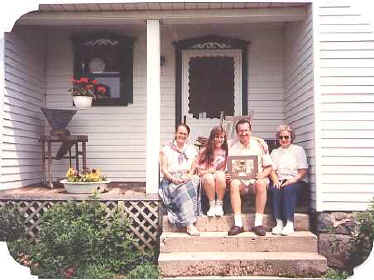
The three of us on the back steps of Delilah’s
home
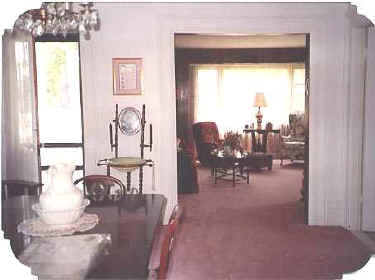
Dining room and living room
Following those two tours in late June 1992, I sent the owners of the two houses pictures we have in our collection from the early days of the houses. See these pictures in these links in the
Scrapbook: “George’s House” (1st picture) and
“The Brick House” (2nd picture)
Grosses’ Grandchildren
(May 2006)
People — Fred and Esther Gross, Laurie, Rick, Tyler (10) and Luke (8) Newman, Lynee Ward, Don and Ginger, Olivia (12), Logan (10), Nolan (9), and Victoria (6) Gross, Bob and Dottie Hoppe, Matt Hoppe
After the two group tours of cemeteries that I led in 1992, fourteen years passed before I had an opportunity to do that again. As I approached my 70th birthday, I had the nerve to suggest that the gift I wanted most was to take all my family—the children who had gone with me in 1992 plus the six grandchildren who had been born since then.
Based on the experiences of my childhood, I suggested we do it on the Memorial-Day weekend. The other thing we did in recognition of past customs was to plant red geraniums at the headstones.
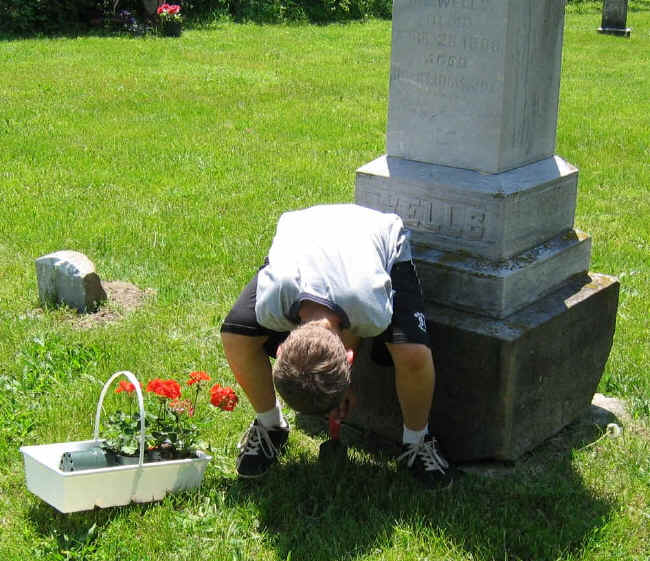
Logan planting the geraniums
During the Mishawaka part of the tour, it was special to show
our Don Paul’s children the grave of the Uncle Don they’d heard so much about and to take a picture of them at the grave—after Don Paul and his kids had worked hard to get the bronze vase free so we could put flowers in it.
A handful of years before that, via the Internet, I had made contact with a Jo Kelly of Conklin, Michigan, who had been working on a history of Chester Township. Over several years she was a great help to me in any number of ways, including a descendancy chart of William Compton as well as tracking down the actual obituary of Samuel Stauffer’s death in the cistern.
Jo was also helpful when it came to the tour I was planning to take my family on. We were camping in a local facility during the Michigan part.
She told us that a local fire station always served a donation-only pancake breakfast on Memorial-Day morning—just perfect for our crowd of campers. Jo also directed us to the Grose Park as a place for us to eat the lunch we brought along.
We had written ahead to the owners of the brick house and given a time we would be stopping by with our group. (That time we were sixteen people and three dogs in four vehicles; mostly vans). We arrived in front of the house at the time we had said we’d be there, and in less than five minutes the owner drove up. He interacted politely with me and I with him, but that time he did not invite me or anyone else to go in the house. That’s okay, it was his house, and we did not want to cause
any conflict (such as between him and his wife…?).
However, in the years since I had been there before, he had created an attractive arrangement over the sealed-off cistern. When I asked if I could approach and get photo of it, he readily agreed. The rest of the group stayed in their cars and watched through the windows. A big disappointment, yes, but still a good experience for those who had never been there to see the house and the “well” in person, even if from a distance.
The owners of the white Porter house, however, whom we had also told in advance about our tour, were just as warm and welcoming as they had been fourteen years before. They invited the whole group in and allowed us to roam the upstairs and this time the basement as well. That’s where we first saw the amazing stones walls. Because my generation’s third-great-grandfather Curtis Porter was a stone mason, it makes sense to us that he would have had a hand in the construction of that incredible basement, though he would have been in his 60s when the house was built.
In addition to showing my grandchildren the graves of the five Porter babies they had heard so much about, it was a thrill to take a picture of six of Curtis’s
fifth -great-grandchildren by his grave. Because it was Memorial Day, a vet flag was in the spike beside it—amazing, knowing it had been 192 years since Curtis served his country near the end of the War of 1812.
In the afternoon, the children were beginning to fade in strength and interest, but Don Paul and Dottie were interested in seeing the Fulton Street Cemetery where Fred and I had located the graves of Delilah Porter’s parents, Jeffrey and Ellis Champlin (learned about in our visit to the County Courthouse in Grand Haven MI; see “Discoveries”).
Highlight — Camping with the family; meeting Jo Kelly;
fifth-great-grandchildren by Curtis’s grave—with a flag on it
Pictures
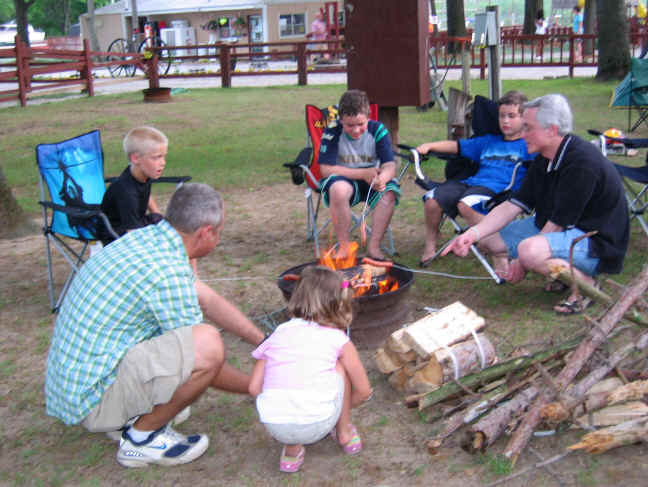
Family camping
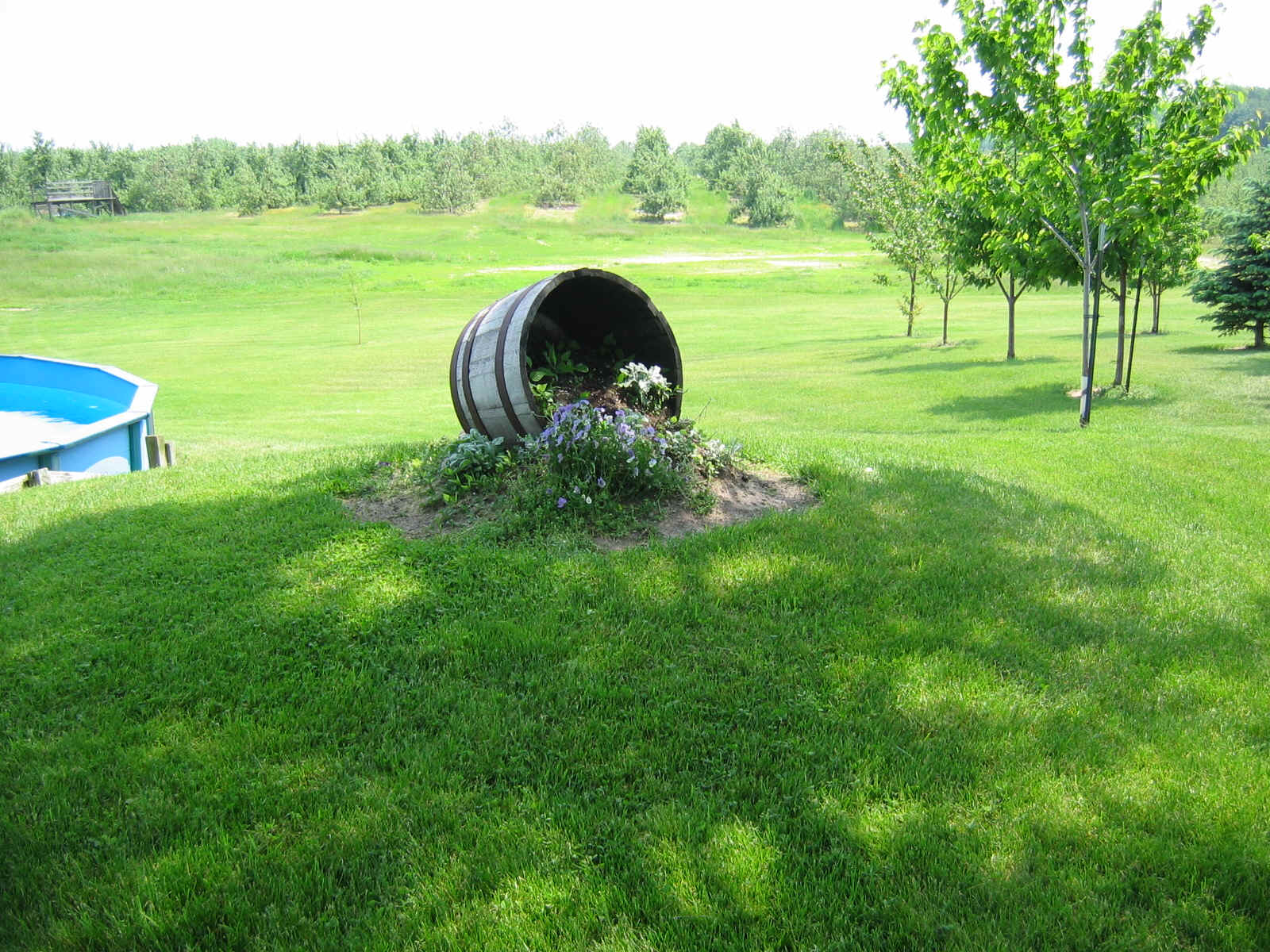
Arrangement at the top of the historic cistern
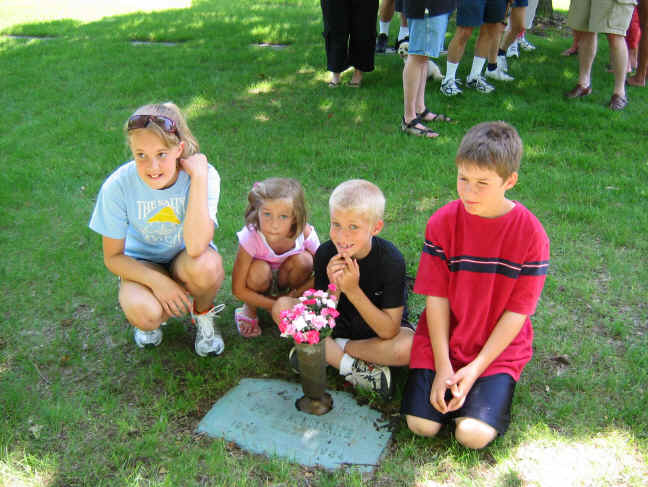
Don Paul Gross’s children at grave of Don Paul Moneysmith
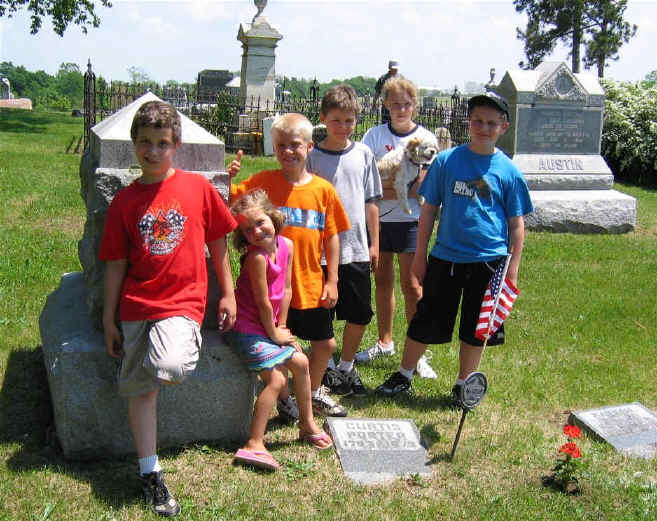
And with their Newman cousins by Curtis’s headstone with vet flag
Matt Hoppe and children
(June 2008)
People — Esther Gross, Dottie Hoppe, Matt, Ethan (13), Naomi (11), and Joel Hoppe (6½)
In the summer of 2008, nephew Matt Hoppe wanted to take his
three children on the ancestor tour. His mother—my sister Dottie—joined us. We stayed in the home of friends of both families, Ray and Sonya Peace, in Hudsonville, Michigan. It turned out to be a special tour with a number of special “first-time” events.
Once again we were welcomed into the white house by the Van Offelins. This time we had Matt take pictures of Dottie and me outside Delilah’s house and of the two of us with our hands on the stones of the wall in the basement that may have been laid by our 3rd great-grandfather who was born during George Washington’s first term as President.
And then there was the brick house, not only where Samuel Stauffer died, but which had played such a large role in the lives of the Hawkins family and appeared in multiple pictures in the family albums. This time someone, likely Matt, knocked on the door, and this time the owner once again graciously allowed us free reign to walk through the downstairs and take pictures.
Matt got a panorama picture of the three downstairs rooms that open from the dining room. It was satisfying to see on the wall, framed and just above a framed aerial shot of the farm, the picture we had sent them of the house when it was new. I was happy to get a picture of Dottie with her granddaughter Naomi in Grandma Porter’s kitchen where she served the visiting preacher two eggs because (hint, hint!) he “had a long journey” ahead of him that day. And it was special for Dottie and me to sit on Grandfather Porter’s front porch and have Matt take our picture there, too.
When we drove by where the schoolhouse had been, this time even the chimney was gone. The whole story about the schoolhouse, including the search we did that day that found the chimney remnants, is written up in “The Porter Schoolhouse” under
Porter in this Scrapbook. We again visited the Champlin graves at the Fulton Street Cemetery in northeast Grand Rapids, as well as the Waite ones at Fairlawn Cemetery.
By far the biggest event of this tour was solving the mystery about Grandpa Hawkins’ mother and tracking down her parents—a whole new branch and generation we hadn’t known about. That is all written up in “Finding Florence’s Roots” under
Hawkins in this Scrapbook.
Highlight — Finding the Huntleys in Pierson; getting pictures with Dottie’s and my hands on Curtis’s stones, going into the brick house again, tracking down the fallen chimney of the school house (we had learned from Jo that it had been called the “Porter School”).
Pictures
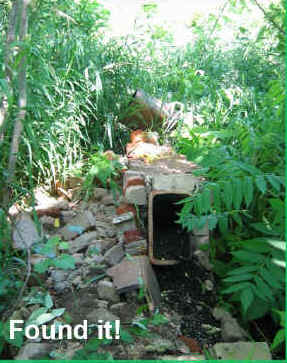
Finding the schoolhouse chimney
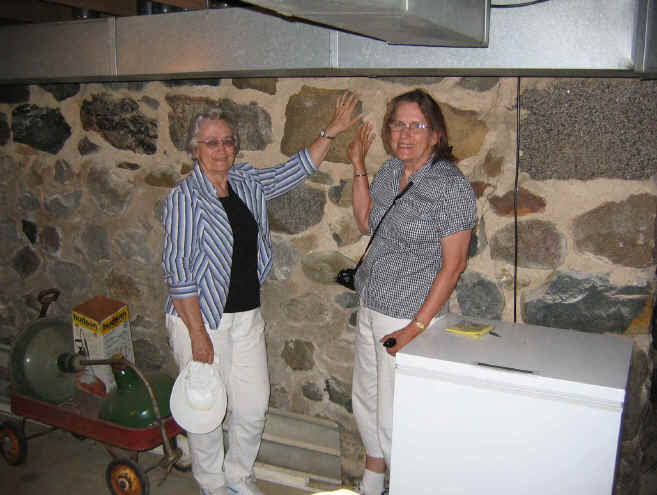
Hands on Curtis’s stones
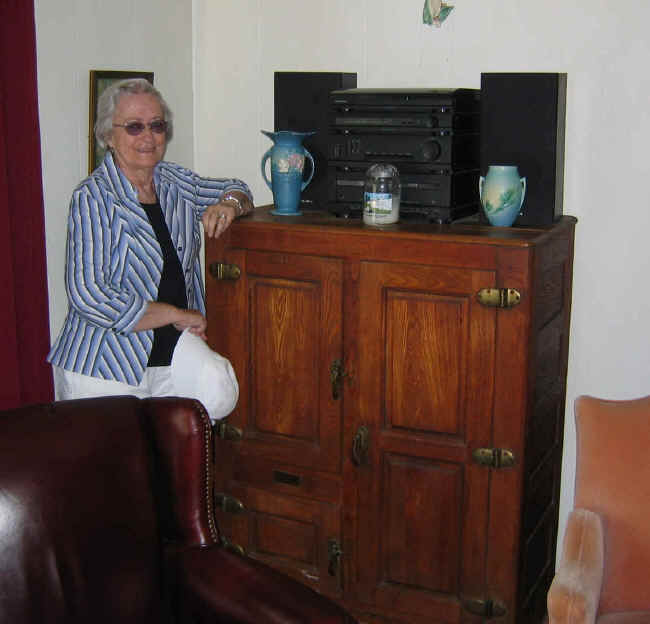
Entertainment center was originally George Porter's
ice chest
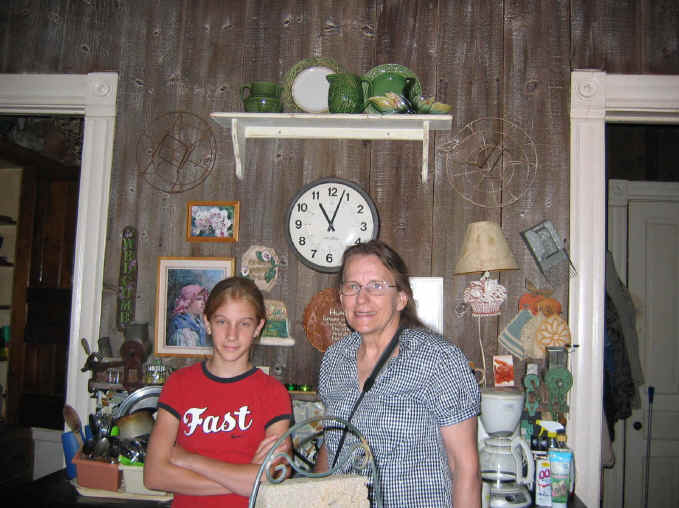
Naomi Hoppe and Grandmother Dottie standing in Grandma Porter’s
kitchen
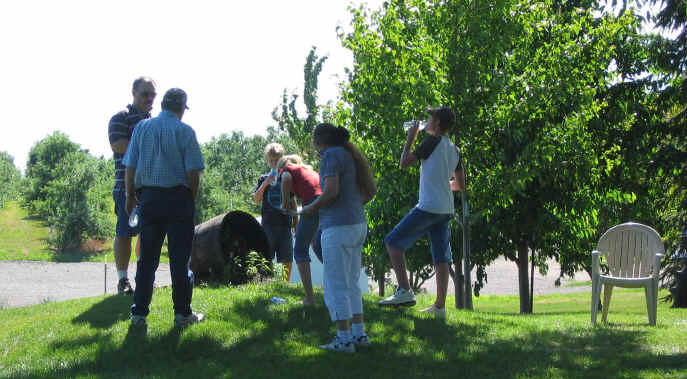
Standing around where the cistern was
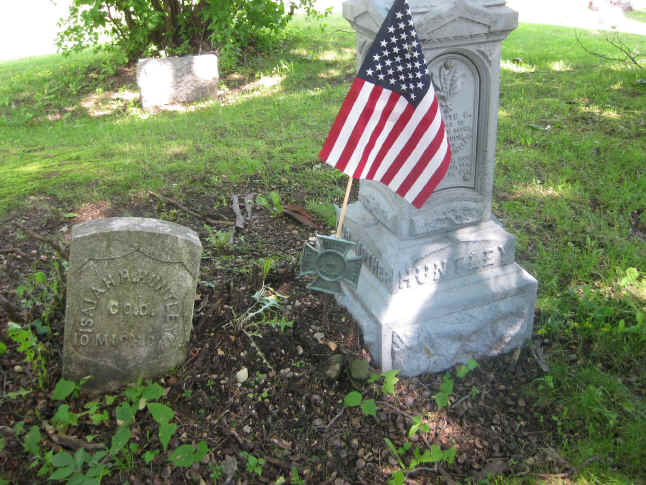
Huntley headstones
Nathan Hoppe’s family
(June 2014)
People — Nathan and Gabriella Hoppe, Tristan (16), Katherine (14), and Daniel Hoppe (4), Fred and Esther Gross, Dottie Hoppe, Erica, Ethan (19), Naomi (18), and Joel Hoppe (13)
Another six years went by before I had the opportunity to do another ancestor tour. Nephew Nathan Hoppe’s family lives and works in Albania. Knowing Nathan had never made the tour, when I knew they were coming to the States in the summer of 2014, I offered to do “one last tour” for them. They took me up on the offer. At the same time, Matt’s wife and children happened to be getting back from a trip to their former ministry location in southern Africa, so they joined us, too. It was a wonderful opportunity for the cousins (who are growing up on different continents) to do something together. Matt wanted so much to join us, but travel complication between Arkansas and Grand Rapids prevented it.
Before this tour, I spent hours working on a better
map of our ancestors’ sites in the area. It was a challenge but also a labor of love. Much of the area northwest of Grand Rapids is easy to map because the roads are numbered, both going north out of town and going east and west. As I worked on it, I marveled that I used to find all those places on my own without a guide or map.
Another project I worked on—since I was still saying it was going to be my last tour—was writing up
directions and things like street addresses for all the sites we visit. That also was a challenge but a satisfying one.
Many things on this tour were fairly routine. Again we had to look at the brick house and cistern site from the road. All we could do was point out the church as we drove by, and of course the schoolhouse wasn’t there. When we noticed how much some of the headstones were becoming covered with mold, it bothered Nathan to the point that he and Gabriella hit a Wal-Mart for cleaning supplies. He tackled one or two of the graves, especial Ferd and Esther Porter’s. Unfortunately, there wasn’t time to do many of them. Another special contribution by Nathan was his determined efforts to rid Delilah’s headstone of the vine that had grown up over it and spread to those on either side of her.
The biggest highlight of this trip was our visit with the Van Oeffelins at the big white Porter house. We were ten on that tour, but once again the Fred and Sue welcomed us warmly. We had figured out on a previous visit that the Van Oeffelins were people of faith much as we are. At one point years before they had attended the brick church up the street from them. Fred really hit it off with Nathan, especially when he learned Nathan is a missionary. As we were leaving that day, Fred wanted to have prayer together, and we did. We have to believe that Great-grandfather George Porter, who built the house, would have been pleased.
We didn’t know it might be our last time—and for sure our last time with the Van Offelins.
Highlight — Time with Nathan’s family; one more and last visit with Van Oeffelins.
Pictures
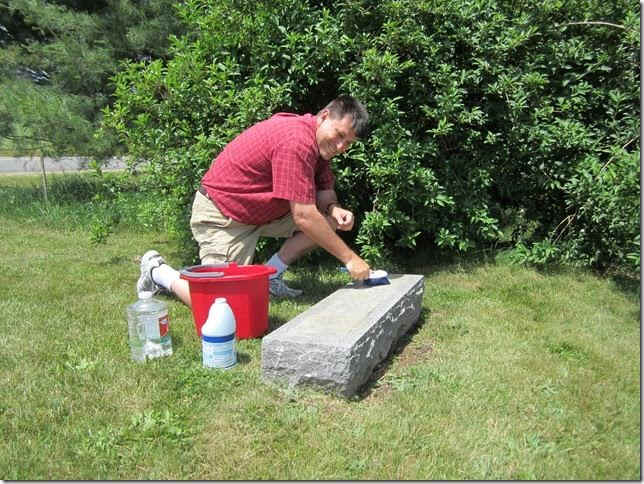
Nathan cleaning mildew from Porter headstone
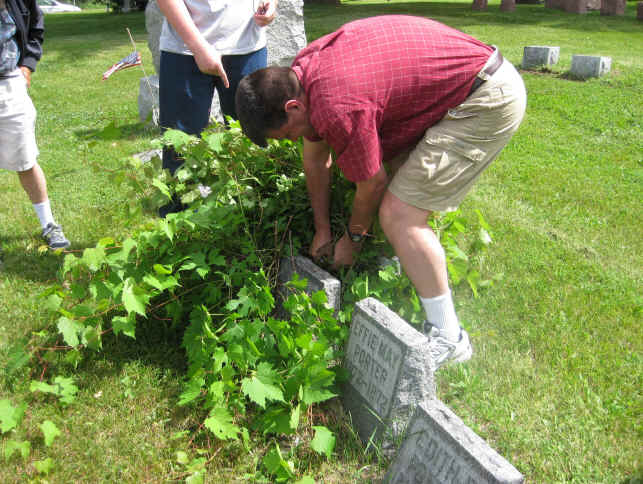
Nathan digging the vine away from Delilah’s and George’s
headstones
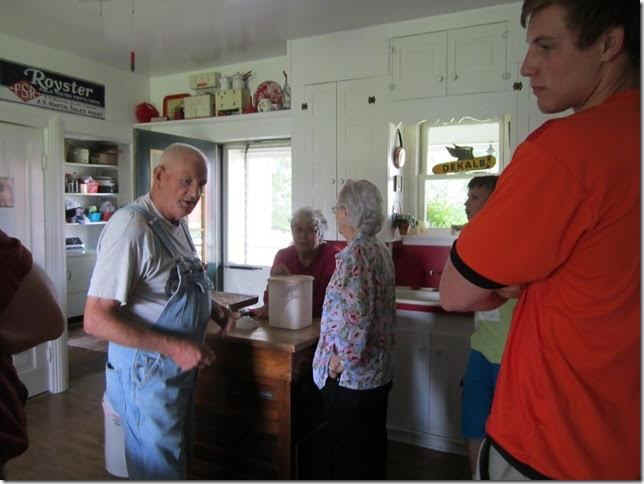
Chatting with Fred Van Offelin in presumably Delilah’s
kitchen
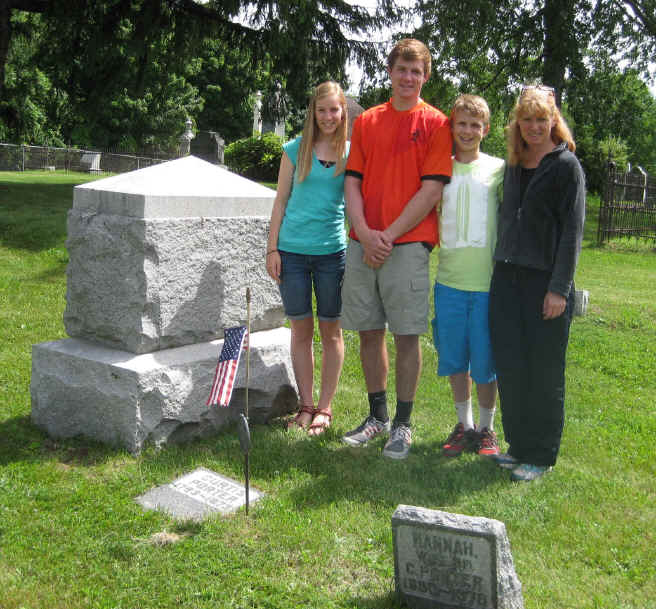
Naomi, Ethan, Joel (fifth-great-grands), and Erica Hoppe by Curtis’s
grave
Rachel Rendón and family
(April 2015)
People — Esther Gross, Rachel, Lilyan (20), Lydia (18), Brienna (14), Analiese (12), Brigietta (9), and Keegan (7) Rendón, Laurie Newman, Lynée Ward
Rachel and her six children had wanted very much to take the tour with us in the summer of 2014, but health issues and consequently being behind with school prevented them from being able to. I had said the 2014 tour would my last, but then it turned out we were going twice that spring to Laurie’s just west of Chicago. Hmmm. That isn’t far from Grand Rapids, so I offered to do a tour for Rachel’s family if they could make it. They saved their money and worked hard on their school work, and we got to do it.
We needed places for Rachel and the children to stay, and cousin Joy Sholte kindly agreed to host them when in Mishawaka—one night at the beginning and another two nights later after they returned from Grand Rapids. Sonya and Ray Peace agreed to host them the night they were in GR, and Marlene and John Jackson agreed to put up the rest of us that night.
From the beginning I told my husband Fred he did not have to go on this tour—he had patiently been on so many of them over the years. When we thought about his staying at Laurie’s, I wondered if
she wouldn’t like to join the tour—to drive, yes, but more importantly to have time with her cousin Rachel and family, which hadn’t happened in years. Lynée was also coming to Laurie’s for the boys’ play, and when she heard about the trip with Rachel, she was eager to get in on it, too. So that worked out well all around.
We had two cars—Rachel’s suburban with her driving and our SUV with Laurie driving. I rode in the front seat with Rachel, while Lydia and Analiese rode with Laurie and Lynée. It turned out wonderfully. I was able to provide Rachel and those in her car, especially Lilyan, with previews and accounts from other tours (that’s what inspired me to write this article). A distinction of the trip was first-time use of cellphone communication between the two cars. The fact that it rained much of the day complicated things a bit.
After looking at the brick house from the road, we drove by the church. Laurie spotted the parsonage just off the back of it and suggested we see if anyone was home. As a result of her initiative, the pastor invited us in and made us feel most welcome. We spent a leisurely time exploring, learning the current news of the church, and having our picture taken gathered around the pulpit. Was it the pulpit Grandpa Hawkins used in 1912-1913? It might have been. The pastor invited members of our family to visit the church at any time. Unfortunately, at this writing no one has been back and able to do that.
And then there was the white house. When we had our great visit with Nathan the summer before, we learned that the owners really wanted to retire and sell it. When Dottie was back there a couple of months later, she learned that they
had sold it, though they hadn’t moved out yet. They said the new owners knew about our family’s interest in the house and about our multiple visits and had said we could still visit if we wanted to.
In advance of our visit, we tried unsuccessfully to contact both the Van Offelins and the new owner. Our two cars with Rachel’s family drove into the driveway in a light rain, and I went to the back door and knocked several times. No response. There was no indication that anyone was home. It was a letdown for sure, but we were still grateful to have been that close to it.
Highlight — Getting into the church, taking pictures, having a great visit with the pastor, and getting a standing invitation to visit anytime; getting to spend in-depth time with family members we don’t see too often.
Pictures
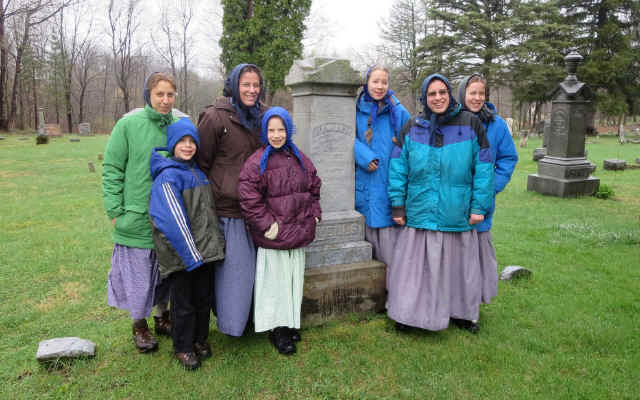
Rachel and children beside the Wells obelisk headstone.
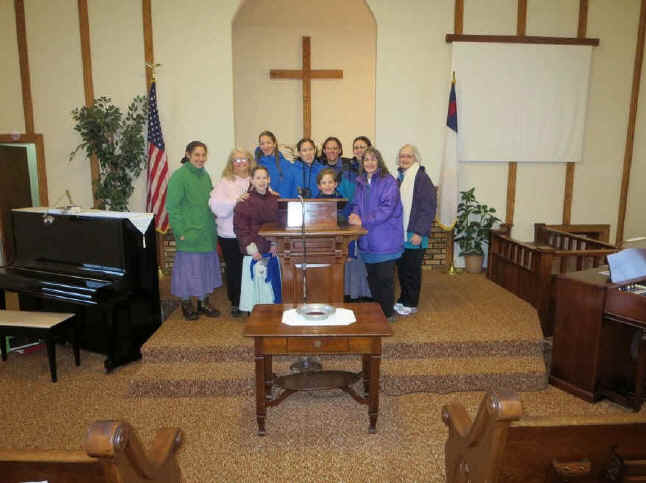
Our whole group inside the North Chester church
Conclusion
What can one say about unusual adventures such as these ancestor-history tours? Every one of them has been a treasure to me—yes about the ancestors, but far more because of the opportunities they have created for descendants in
this generation to have times together that we wouldn’t have had otherwise. I’d love to mention names, beginning with Agnes and Lyman in 1992, but the names are in the accounts, so I won’t repeat them here.
Why make a written record of all this? One thing is to have all the accounts somewhere besides just in my head. Another reason I envision is that it may allow someone who never got to make a tour the opportunity to at least learn something about it all.
I can never thank God enough for the godly heritage He granted me/us through so many branches of those who went before us. I hope others who share the heritage with me are also grateful. It has been a privilege to make that heritage better known to other family members who are fellow descendants along with me.
|